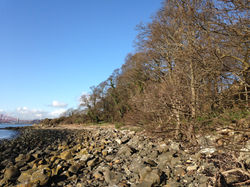November Blog
Here we are in mid November but, unlike in the USA, we have yet to experience any of the winter weather that is usual for this time of year, and our mild weather is affecting what we can see in the woods at present.

On any walk through the woodlands at this time you do not normally expect to see flowers in bloom, but ivy is an exception. While we are are familiar with them coating the ground or climbing walls and trees, when the plants have reached a sufficient size, and have access to some autumn sunshine, they produce clusters of simple yellowish flowers in late autumn. Although not attractive as flowers go they are an important source of nectar and pollen for a range of flies and other insects, as here; and these in turn will help sustain our wrens and other insect eating birds over the cold to come.
But in the mild conditions we have experienced so far this year some other species are also producing occasional flowers. Red Campion and Welted Thistle, that would normally have finished flowering, have put some energy into late blooms that brighten up a November walk along the woodland edge paths.


On the shore side of Bathing House Wood, on the approach to the steps, some white flowers can be seen, adding a little brightness to the top of the beach; these are of Scentless Mayweed.
After a very dry August and September we finally got some much needed rain in October and November. Despite appearances however this has still not penetrated far into woodland soils. This became apparent when transplanting some of the wildflowers into the Crow Wood bank; the moist surface soil layer only extended down about 6 to 8 cm; beneath that it was still very dry.
But there has nevertheless been enough rain to encourage seedlings to germinate and for fungus fruiting bodies to emerge, and it is good to see that where the gorse clearing was done in the summer the exposed soils are now covered in seedlings which have germinated from the bank of seeds that had lain dormant over the years. Some of these will no doubt prove to be more gorse, but there appeared to be quite a selection of different appearances and these will be of species that will have flowered there in the years before they were smothered by the expanding gorse, so it will be interesting to see what they develop into next spring and summer. In other parts of the cleared area Foxgloves have already grown out of some of the cracks in the rocks which were once covered by the gorse, so they will certainly be ready for flowering next summer.


While flowers may be scarse, some of the fungi that have developed help to make up for the lack of colour, most striking is the bright orange of the fungus growing on one of the felled trees in Hopeward Wood which looks to be the Velvet Shank (Flamulina velutipes), and among the decaying cut brash near where the Coastal Path leaves Lumsdaine Drive is the unusual pale purple of another fungus, that may possibly be Cortinarius anthacinus (this one does not have a common name). Joy’s earlier photo captures the colour of the gills when they were still undamaged by grazing slugs and snails. In Joy's photo alongside it is another orange/russet fungus, most probably one of the many Lactarius species.




Another wood decaying fungus on the felled tree, and shown below, is the pale fawn of what may be the Oyster Fungus (Pleurotus ostreatus) and among the nettles growing on the decaying litter of dumped garden material are specimens of one of the many species of aptly named bonnet fungi.


Some other pale fungi that Joy captured are shown below, displaying more of the variation in colour and appearance that can be seen in this fascinating, varied and very important group of organisms.


The identities of these fungi can only be tentative, but the illustrations do show some of the range of species that may be seen by careful observation in a walk around our woodlands. While they are fascinating to look at, considerable caution should of course be taken in handling any of them; some may be poisonous, and in any case they are really best left where they are growing. They can then spread their spores to colonise other substrates and, as these fruiting bodies finally also decay, they can provide food for a range of other invertebrates and so contribute energy and nutrients to the food web of our woodlands.
Dick Alderson
21 November 2014







































